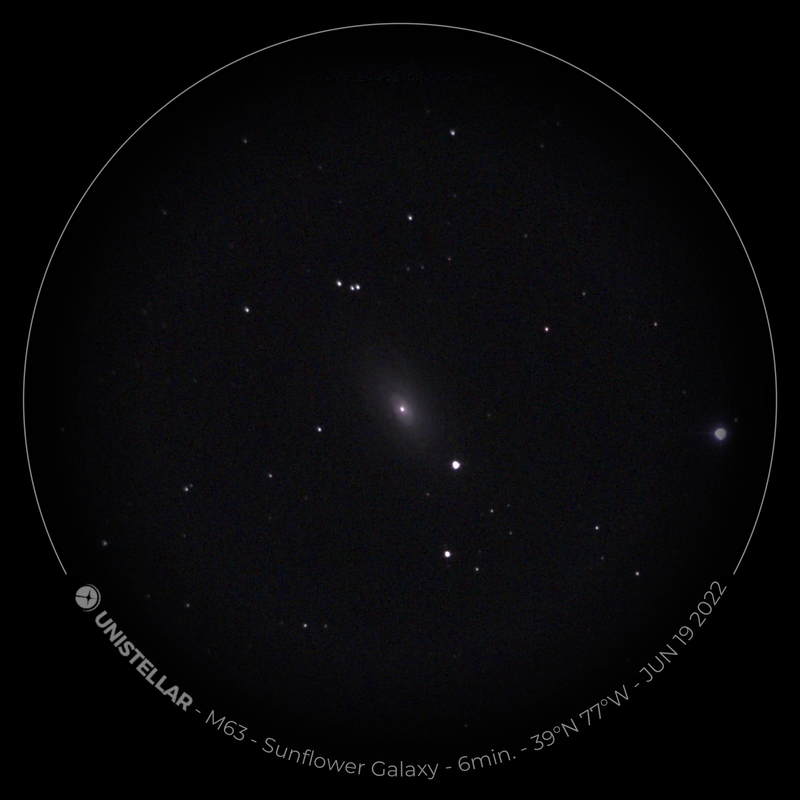|
It was Father's Day yesterday, and I had sanction to wake up late. When I found out the night would be clear, I was full of anticipation - until I realized that seeing was forecast to be about as bad as I can remember. I stepped out after sundown, however, and found the stars unusually visible in the night sky. Sure enough, transparency was high above average - which made sense, as the night as unusually crisp for a DC summer. Out I stepped at around 1:30 AM, burdened like a Tolkien dwarf with the EVScope II on my back, and a tripod in hand. This time I walked to a nearby school's soccer pitch, which not only affords an impressive view of the whole sky but is also (strangely) bereft of street lights. I set up in a few seconds, then targeted the heart of the Milky Way as it rose well above the southeastern horizon. The light pollution is very bad in that direction - it's right above the National Mall - but still, I had high hopes. I've largely praised the EVScope in these pages, and rightfully so. In a matter of moments the Omega Nebula emerged from the background light pollution, and wow that is an impressive effect. After a five-minute exposure, I moved on to the Lagoon Nebula, with much the same results. I now slewed to the Owl Nebula, but this time the view underwhelmed - even after five minutes - and it's not surprising: at around tenth magnitude, it's a challenge for the EVScope in light-polluted skies. As the chill began to set in, I finished up with the Sunflower Galaxy: a faint spiral roughly the size of the Milky Way, 27 million light years distant. It was a subtle view after six minutes or so, but still recognizable. I had profoundly mixed feelings as I walked home. On the one hand, it continues to amaze me that the EVScope brings nebulae and galaxies within my reach, from downtown DC. On the other - and this can't be stressed enough - using the telescope is not comparable to traditional observing. With a regular telescope, the bulk of your time is spent straining at the eyepiece. You train yourself to see like observers have for centuries - using averted vision, for example - and there's an art to it that you can improve over time. When you're not observing the obviously spectacular - Saturn or the Moon, for example - then what's visible through the eyepiece can be absurdly subtle. The average person would never recognize, let alone appreciate, what you can just barely glimpse. What makes it special is the sensation of seeing with your own eyes what can otherwise be admired only in enhanced pictures. You are truly experiencing the universe, albeit only as well as imperfect optics and a turbulent atmosphere will permit on any given night. With the EVScope, by contrast, you navigate an app on your phone. You stare at a screen as the telescope effortlessly targets and then observes your chosen object for you. Slowly, a picture emerges of the object you've selected. It's a little like a picture you can Google - something taken by Hubble, for example - except way worse. As the picture slowly brightens, you wait. You scroll through other stuff on your phone, perhaps, or you sit there thinking. One thing is for sure: most of the time, you aren't actually looking at space at all. Eventually, you turn your attention back to the app and if you're satisfied enough with the picture, you target something else. You end up with pictures that look impressive when they're small, on your phone, but - owing to their resolution or the unavoidable influence of light pollution - underwhelm when you blow them up on your laptop.
It's exciting to find what's out there, in the sky, that you could never see with traditional optics (barring a difficult-to-use astrophotography setup, of course). But sometimes, walking home, the experience leaves you cold. Sometimes, you feel like all you've done is played with screens. You haven't really experienced nature, and you certainly haven't learned an art. Everything was easy, so occasionally it feels like little was gained. You might as well played with a screen at home. On some nights, the EVScope can feel like a toy - whereas a more traditional telescope always feels like a tool. Maybe that's because of how and where I'm using the EVScope. Maybe the telescope could do more under a darker sky, and certainly the EVScope comes with citizen science features that I haven't begun to access yet. But with the similarly-priced FC 100DZ, for example, I feel like I'm engaging in an old art with a rich history. With the EVScope, I often feel more like I'm playing a game on my phone. Both have their virtues, but if I had to choose one telescope - it would be the refractor.
0 Comments
|
Archives
March 2024
Categories
All
|







 RSS Feed
RSS Feed